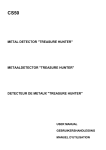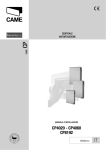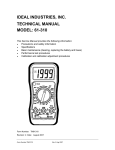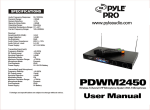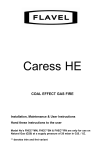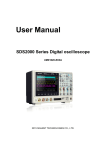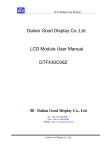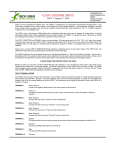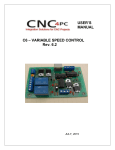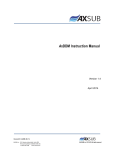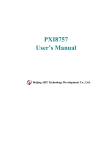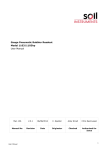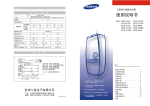Download CP4000 series current probes user manual
Transcript
\\\\ CP4000series AC/DC current probe INSTRUCTION CP4060 CP4200 MANUAL General Safety Instructions: Read the following safety instructions to avoid injury and prevent damage to this product or any products connected to it. Use this product only as specified. Only qualified personnel should perform service procedures. To Avoid Fire or Personal Injury Connect and Disconnect Properly. Connect the probe output to the measurement instrument before connecting the probe to the circuit under test. Disconnect the probe input and the probe ground from the circuit under test before disconnecting the probe from the measurement instrument. Observe All Terminal Ratings. To avoid fire or shock hazard, observe all rating and markings on the product. Consult the instruction manual for further ratings information before making connections to the product. Replace Batteries Properly. Replace batteries only with the proper type and rating specified. Do Not Operate Without Covers. Do not operate this product without the covers or panels. Avoid Exposed Circuitry. Do not touch exposed connections and components when power is present. 1 Do Not Operate With Suspected Failures. If you suspect there is damage to this product, have it inspected by qualified service personnel. Do Not Operate in Wet/Damp Conditions. Do Not Operate in an Explosive Atmosphere. Keep Product Surfaces Clean and Dry. Safety Terms and Symbols: Terms in This Manual. These terms may appear in this manual: WARNING. Warning statements identify conditions or practices that could result in injury or loss of life. CAUTION. Caution statements identify conditions or practices that could result in damage to this product or other property. Terms on the Product. These terms may appear on the product: DANGER indicates an injury hazard immediately accessible as you read the marking. WARNING indicates an injury hazard not immediately accessible as you read the marking. CAUTION indicates a hazard to property including the product. Symbols on the Product. These symbols may appear on the product: Attention refer to operation Instructions. 2 This instrument has double insulation. Getting Started: The current probe enables a general purpose oscilloscope to display AC and DC current signals up to 500 amps Peak (180 A RMS). The current probe can also make AC and DC measurements with a multimeter by using the recommended accessory MT-246N (BNC-to-banana) plug adapter. PIC 1 Output Into Scope Press Button Battery Cover Test Position Max. 11¢Wire DC Zero Offset 3 Range Selection (Power On/Off) Shows the controls and indicators on the current probe. Control/Indicator Description Current flow symbol. The arrow shows the probe’s polarity convention for measuring current flowing from positive to negative. Zero adjustment. Rotate to adjust the probe output to zero when there is no current present. It may also be used to offset a DC signal component. Zeroing is not needed for AC measurements unless your instrument cannot isolate a DC component (if present). OFF/Range switch. Slide the switch from OFF to either the 5 mV/A or 50mV/A range. When either range is selected, the probe is turned on, and the green battery indicator lights. If the indicator does not light, see Battery Notes and Battery Installation on page11. Battery indicator. The green battery indicator lights when the probe is turned on. For more information, see Battery Notes and Battery Installation on page11. Overload indicator. The red overload indicator lights if the measured signal is greater than the selected range capacity. Switch the probe to 10 mV/A if possible, or remove the probe from the circuit. Specifications: These characteristics apply to an adjusted CP4000 AC/DC Current Probe installed on an oscilloscope of any brand. The oscilloscope must be warmed up for at least 20 minutes and be in an environment with the temperature at 10℃~30℃ and the humidity at 0~80. 4 Size 231 mm x67 mm x 36 mm Maximum Conductor Size 10.3 mm Cable Length 200 cm Weight 310 g (without battery) Environmental Characteristics Temperature Working 0°C to +50°C (+32°F to +122°F) Storage -20°C to +80°C (-4°F to +176°F) Humidity 0°C to 40°C, 95% humidity 40°C to 50°C, 45% humidity Pollution Degree 2 CP4060 Basic Operation: Before using the probe, the batteries must be installed. WARNING! Do not clamp the probe onto circuits with voltages greater than 600VAC. Personal injury or damage to the probe may result. Always connect the CP4060 current probe output to the 5 instrument before clamping onto the circuit under test. 1. First connect the current probe BNC connector to BP-250 (double BNC connection cable) then connect to oscilloscope input. Start by setting the oscilloscope voltage input channel to DC volts, and the voltage sensitivity scale to 5m V/div. 2. Move the OFF/ Range switch to the 5 mV/A or 50 mV/A position to turn on the probe. (※The CP4060 current probe has a green LED power/battery indicator. If the LED does not light, replace the battery or use specified power adaptor.) 3. Use the ZERO adjustment to zero or offset the probe output detection of residual magnetic DC charges. 4. Connect the probe to the circuit by opening the jaws and clamping around the conductor. NOTE. Clamping around both the “hot” and neutral wires may give you a zero reading. (Remember to unclamp the probe from the conductor before disconnecting it from your meter or instrument). 5. Adjust the probe channel and oscilloscope’s time base as necessary to get a clear and stable view of the signal. Set the oscilloscope input to DC volts to see both the AC and DC currents; set the channel to AC to see the AC current only. 6 6.The current drawn by different devices look much different than that of others. While the RMS current can only be used in low frequency current, the momentary peaks may be quite high. 7.Congratulations on your purchase of the CP4060, a multifunctional current probe. When connecting to a digital meter, use the recommended MT-246N (BNC-to-banana adapter). Connect the black lead to the meter COM (black letters on the meter), and the red lead to the VΩ input (red letters on the meter). 8.To measure only AC current, set the meter to measure AC volts. 9.To measure DC current, set the meter to measure DC volts. Note the current convention arrow on the probe to get the proper polarity reading. 10.To increase the measurement sensitivity of the CP4060 current probe, loop additional turns of the wire under test through the jaws. See Figure 1. The sensitivity of the CP4060 current probe is multiplied times the number of loops in the jaws. For example: 50mV/A X5turns=250mV/A Figure 1 7 Electrical Characteristics Current Range 5mV/A ; 50mV/A ±2% ±0.4 mA at 50mV/A (0.4mA to 10 A peak range) DC Accuracy, typical ±2% ± 1A at 5mV/A (1A to 60 A peak range) Maximum Working Current 60A Frequency Range DC to 100KHz (-3 dB) Rise time,typical 2.5uS Noise(Max) 2mV pk-pk Battery 9Vbattery Voltage and current ratings Maximum working current(A) Maximum Working voltage (V) Maximum floating voltage (V) Range 5mV/A Range 50mV/A Maximum Working voltage (V) Maximum floating voltage (V) DC 50 5 600 600 DC + peak AC 50 5 600 600 AC peak 50 5 600 600 AC peak-peak 100 10 1200 - RMS CAT III 35.4 3.54 600 600 RMS 35.4 3.54 600 600 RMS CAT I 35.4 3.54 600 600 Rating Rating 測定 CAT II CP4200 Basic Operation: Before using the probe, the batteries must be installed. 8 WARNING! Do not clamp the probe onto circuits with voltages greater than 600V AC. Personal injury or damage to the probe may result. Always connect the CP4200 current probe output to the instrument before clamping onto the circuit under test. 1. First connect the current probe BNC connector to BP-250 (double BNC connection cable) then connect to oscilloscope input. Start by setting the oscilloscope voltage input channel to DC volts, and the voltage sensitivity scale to 5m V/div. 2. Move the OFF/ Range switch to the 5 mV/A or 50 mV/A position to turn on the probe. (※The CP4200 current probe has a green LED power/battery indicator. If the LED does not light, replace the battery or use specified power adapter.) 3. Use the ZERO adjustment to zero or offset the probe output detection of residual magnetic DC charges. 4. Connect the probe to the circuit by opening the jaws and clamping around the conductor. NOTE. Clamping around both the “hot” and neutral wires may give you a zero reading. 9 (Remember to unclamp the probe from the conductor before disconnecting it from your meter or instrument). 5. Adjust the probe channel and oscilloscope’s time base as necessary to get a clear and stable view of the signal. Set the oscilloscope input to DC volts to see both the AC and DC currents; set the channel to AC to see the AC current only. The current drawn by different devices look much different than that of others. While the RMS current can only be used in low frequency current, the momentary peaks may be quite high. Figure 3 shows the difference between the line current drawn by a resistive load and a motor controller. Congratulations on your purchase of the CP4200, a multifunctional current probe. When connecting to a digital meter, use the recommended MT-246N (BNC-to-banana adapter). Connect the black lead to the meter COM (black letters on the meter), and the red lead to the VΩ input (red letters on the meter). To measure only AC current, set the meter to measure AC volts. To measure DC current, set the meter to measure DC volts. Note the current convention arrow on the probe to get the proper polarity reading. To increase the measurement sensitivity of the CP4200 current probe, loop additional turns of the wire under test through the jaws. 10 See Figure 2. The sensitivity of the CP4200 current probe is multiplied times the number ofloops in the jaws. For example: 50mV/A X5turns=250mV/A Figure 2 Electrical Characteristics Current Range 5mV/A ;50mV/A ±2% ±0.4 mA at 50mV/A (0.4mA to 10 A peak range) DC Accuracy, typical ±2% ± 1A at 5mV/A (1A to 200 A peak range) Maximum Working Current 200A Frequency Range DC to 150KHz (-3 dB) Rise time,typical 2.3uS Noise(Max) 2mV pk-pk Battery 9Vbattery 11 Voltage and current ratings Maximum working current(A) Maximum Working voltage (V) Maximum floating voltage (V) Range 5mV/A Range 50mV/A Maximum Working voltage (V) Maximum floating voltage (V) DC 100 10 600 600 DC + peak AC 100 10 600 600 AC peak 100 10 600 600 AC peak-peak 200 20 1200 - RMS CAT III RMS 70.7 7.07 600 600 70.7 7.07 600 600 RMS CAT I 70.7 7.07 600 600 Rating Rating 測定 CAT II 1. Notes on Battery and Power Converter: The CP4000 current probe uses a single square 9 V battery. This machine is a high power product. Please use the specified alkaline battery. As the battery in the CP4000 current probe is drained, significant gain errors may occur. The green LED will continue to light until a low battery voltage of 6.5 V is reached. If probe gain errors are detected, replace the battery with a fresh one. If not using this item(more than 1 week),we suggest you remove the battery from the compartment. This is because heating will result in battery leakage, and battery electrolyte will rust the circuit board,thus creating major damage. Furthermore, batteries are high 12 pollution products and therefore by reducing their usage, we will in turn protect the environment. This will avoid leakage of battery since the quality of the batteries is something that is out of our control. 2. Battery Installation: (1) Remove the probe from the circuit. (2) Open the battery compartment by taking the cover off. Install/replace the battery. (3) While observing polarity, attach the new alkaline battery to the battery connector buttons and place the battery in the specified area. (4) Place the cover back and lightly tighten the cover in place. 3. Cleaning: To clean the probe exterior, use a soft cloth dampened in a solution of mild detergent and water. To clean the core, open the jaw and clean the exposed core surfaces with a cotton swap dampened with isopropyl alcohol (isopropanol). Lubricate the jaws mating surfaces with light oil. Do not clean with solvents or abrasives. Do not immerse the probe. 4. Preparation for Shipment Our company has designed a special box to be used for CP4000, 13 convenient for storage and shipment. Please do not discard it. If the original packaging is unfit for use or not available, use the following packaging guidelines: (1) Use a sturdy shipping carton having inside dimensions at least one inch greater than the probe dimensions. (2) (2) Put the probe into a plastic bag or wrap to protect it from dampness. (3) Place the probe into the box and stabilize it with light packaging material. (4) Seal the carton with shipping tape. Replaceable Parts: The CP4000 AC/DC Current Probe is shipped with the following items: One instruction manual One 9V battery Recommended accessory for use with digital meter: One BNC to banana plug adapter Product number MT-246N. Designed with color fool proof design to avoid polarity mistake when connecting to digital meter. The CP4000 series does not have any user repairable assemblies. If you should, have trouble with your probe, contact your local Service Center or representative for help. 14
















